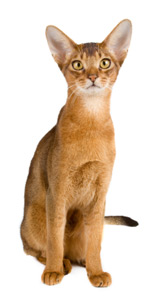|
The Scratching Post
Abyssinian 
The Abyssinian is a medium-sized cat with a very elegant and regal look. They have strong, lithe bodies and long, slender legs.
Their small paws are oval-shaped. Their heads are wedge-shaped and round. The ears are large, pointed and set far apart.
Their eyes are large and almond-shaped. The coat should be fine, short and close to the body.
Their tail is long and tapers to a point. The most common color is ruddy; however, red, blue, fawn and silver are also seen.
White should only been seen around the lips and lower jaw. Too much white in this area or on other parts of the body is considered
a fault.
|
|
Temperament
|
The Abyssinian cat has a lively personality, showing interest in all activities around him. He is also a
very "people oriented" cat. Abyssinians enjoy being with their humans and are very intelligent,
affectionate and loyal. This breed is highly sensitive to their owner?s state of mind, happily keeping
them company during good times, and sharing in their sorrow and sadness during bad times. The female of this
breed prefers to be the only cat in the home.
|
|
Weight
|
9-16 lbs.
|
|
Health Problems
|
This breed is prone to Progressive Retinal Atrophy (PRA), neurological storage disease and renal amyloidosis, which is a form of
kidney disease.
|
|
Living Conditions
|
The Abyssinian should be in a household where people are usually home. They hate to be confined and need plenty of space.
They will appreciate a garden full of trees and high places.
|
|
Exercise
|
The Abyssinian considers playing with their owners to be a daily routine. They display a certain affinity for water and are
said to be good swimmers and excellent climbers.
|
|
Life Expectancy
|
About 9-15 years
|
|
Grooming
|
This breed?s coat is easy to care for. Brush and comb through occasionally and polish with a damp chamois to bring out
the coat?s shine. Use a rubber mitt to remove dead hairs. They are light shedders.
|
|
Origin
|
The Abyssinian is considered to be the cat that Ancient Egyptians worshipped looking very similar to mummified cats
that have been discovered. The earliest identifiable Abyssinian is a taxidermal exhibit still residing in the Leiden
Zoological Museum in Holland. This ruddy ticked cat was purchased around 1834-1836 from a supplier of small
wild cat exhibits and labeled by the museum founder as "Patrie, Domestica India." Although the Aby as a breed was
refined in England, its introduction to that country and others may have been the result of colonists and merchants
stopping in Calcutta, a major port for the Indian Ocean. The first Abyssinians to be imported to North America from England
arrived in the early 1900s, but it was not until the late 1930s that several top quality Abys were exported from Britain to
form the foundation of today?s American breeding programs.
|